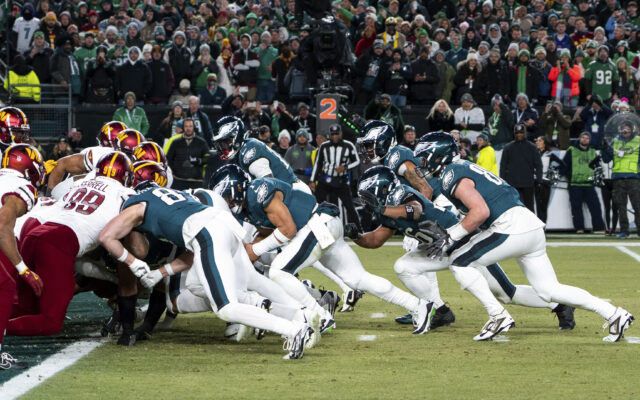
The tush push is still illegal in Maine high school football
By Matt Junker, Bangor Daily News Staff
The Philadelphia Eagles will be able to continue their successful short yardage play, known as the “tush push,” after NFL owners rejected a proposal to ban the much-debated maneuver.
But don’t expect to see the play taking hold in Maine high school football — at least not legally.
Two Maine high school football rules officials explained to the Bangor Daily News how the tush push, which involves offensive players lining up in the backfield and helping to push the quarterback forward once the ball is snapped, conflicts with a “helping the runner” rule.
“The procedure is, if you start to see it, you blow the play dead,” said Allan Snell from Maine’s association for football officials.
The helping the runner rule applies across the country where state organizations follow the National Federation of State High School Associations football rulebook. The helping the runner rule says that an offensive player can’t push, pull or lift the ballcarier to advance their forward progress.
Ralph Damren, who has been refereeing Maine football games for decades, is also the football rules interpreter for Maine and represents the state at NFHS Football Rules Committee meetings. In that role, he helps referees across the state understand and implement those rules.
“Our stance on the tush push, or whatever you want to call it, is that the forward progress has stopped once the runner’s ability to advance on his own has stopped,” Damren explained. “So we don’t flag it for helping the runner, we just kill the play. And rule that the ball is dead right where it is.”
A particularly aggressive case could be flagged for a five-yard helping the runner penalty, the Maine officials explained, but typically referees would just blow a play dead once they see a player pushing a teammate to advance forward progress.
Different states could have different interpretations of the helping the runner rule and how it applies to a tush-push-like play, Damren said.
Damren said that plays like this could happen either in goal line situations or other short yardage plays.
“You might see it on the goal line, but a lot of times you would see it on a close to a first down situation where his teammates want to push him to gain an extra inch, maybe” Damren said.
The tush push is also sometimes called the “Brotherly Shove” for its association with the Philadelphia Eagles. Snell said it may be popular with some teams in the NFL, but the approach raises some competitive and safety concerns at the high school level. Damren likened the tush push to a rugby scrum.
“Rugby is a very, very risky sport,” Damren added. “And I don’t think we want to turn football into rugby.”
NFHS felt strongly enough about dissuading the tush push in high school football that it made the helping the runner rule an official point of emphasis in 2023.
“Rule changes have been made at higher levels of football allowing offensive teams to pile in behind and directly push the runner. Because of these changes, we are now seeing similar plays at the high school level,” NFHS wrote at the time. “As guardians of the game, it is imperative that all stakeholders work together to remove ‘helping the runner’ from our high school game.”
Damren said coaches have been “very amicable” about officials’ approach to not allowing tush-push-like plays in Maine high school football, and that they “haven’t run into any problems” with it in the last few years.
Bangor High School football coach Dave Morris said he doesn’t really have an opinion on the tush push in the NFL and wasn’t overly familiar with the Eagles’ formation and approach with the play beyond seeing it on TV a few times.
“I think in high school football, if you’re relying on that to get the yardage, then you’re probably not doing what you probably could be doing up front, in terms of blocking and trying to dominate somebody up front,” Morris said.